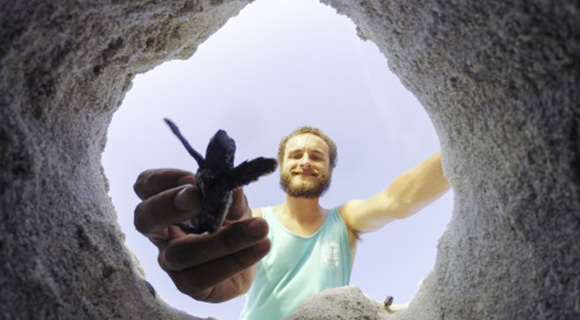Endangered Green Sea Turtles Break Nesting Record on Florida Beaches
By UCFTODAY // September 3, 2015
first time nests have surpassed 12,000
ABOVE VIDEO: Endangered green sea turtles, once on the brink of disappearing, love Florida beaches, and for a second time in the past three years they are setting records.
BREVARD COUNTY, FLORIDA – Endangered green sea turtles, once on the brink of disappearing, love Florida beaches, and for a second time in the past three years they are setting records.
University of Central Florida researchers counted 12,026 green turtle nests in the Archie Carr National Wildlife Refuge along Brevard County’s coastline this week, shattering a record the turtles set in 2013 with 11,839 nests. It is the first time green turtle nests have surpassed 12,000. And the nesting season still has two months to go.
“This is really a comeback story,” said Kate Mansfield, a UCF assistant professor of biology and lead of the Marine Turtle Research Group, a team of students and research scientists who monitor turtle counts on the beach during turtle nesting season — May 1 to Oct. 1 each year.

“Back in the 1980s the beaches UCF monitored hosted less than 50 green turtle nests a year,” she said.
“It is a really remarkable recovery and reflects a ‘perfect storm’ of conservation successes—from the establishment of the Archie Carr, to implementing the Endangered Species Act, among many other conservation initiatives. It will be very exciting to see what happens over the next 20 plus years.”
The green turtles are just one of three species that use the refuge as their nesting grounds. The endangered leatherbacks and threatened loggerheads also love Florida’s beaches. The Sunshine State supports approximately 80 percent of all sea turtle nesting in the United States and the Archie Carr National Wildlife Refuge is home to one of the largest nesting beaches for loggerhead turtles in the Western Hemisphere.
“I strongly hope this milestone is only a hint of what the future holds for Archie Carr National Wildlife Refuge and that UCF’s work leads to the steady recovery for the sea turtle species that begin their lives here,” said Anibal Vazquez, the refuge assistant manager.

The Marine Turtle Research Group at UCF has been monitoring all turtle nests on the 13-mile stretch of beach for more than 30 years. Retired professor Llew Ehrhart founded the program in the 1970s and his early work helped Archie Carr earn national refuge status in 1991.
The research group does much more when it comes to sea turtle research on the coast.
It monitors up to 25 miles along the Central Florida coast from just north of Sebastian Inlet near Melbourne Beach to Patrick Air Force Base, including the Archie Carr refuge.
The group maintains more than 35 years of data for sea turtle nesting and reproductive assessments for this stretch of coastline. For more than 30 years, the team has also conducted in-water surveys of juvenile sea turtles that are found foraging in the Indian River Lagoon, an important developmental habitat for loggerhead and green turtles.
The team conducts work in the northern Gulf of Mexico in order to satellite-track very small, oceanic stage sea turtles captured in the region and associated with the BP oil spill.
This is an on-going project that provides the world’s first data on wild-caught oceanic (“lost years”) juvenile turtles.
With Mansfield’s novel research satellite tracking the sea turtle “lost years,” the research group is evolving into a center for whole life-history sea turtle research—from eggs to adulthood.











